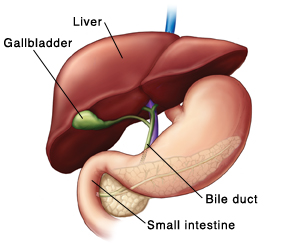A
B
C
D
E
F
G
H
I
J
K
L
M
N
O
P
Q
R
S
T
U
V
W
X
Y
Z
Click a letter to see a list of conditions beginning with that letter.
Click 'Topic Index' to return to the index for the current topic.
Click 'Library Index' to return to the listing of all topics.
HIDA Scan
A HIDA (hepatobiliary iminodiacetic acid ) scan is an imaging test. It can be used to check for problems in the liver, gallbladder, and the tubes inside and outside the liver (bile ducts). During the test, a small amount of radioactive substance (tracer) is injected into a vein in your arm or hand. Pictures are then taken to track the movement of the tracer. The test takes about 2 hours. In some cases, more pictures may need to be taken after a wait of 4 hours. You’ll be told as the test progresses how long your test may take.

Before the test
-
Follow any directions you’re given for not eating or drinking before the procedure. Your healthcare provider will give you instructions if required.
-
Tell your healthcare provider what medicines you’re taking. This includes vitamins, herbs, and over-the-counter medicines. You may be told to stop taking some or all of them in the days before the test.
-
Follow any other instructions you’re given to get ready for the test.
What to tell the technologist
Let the technologist know if you:
-
Are taking any medicines or have allergies to any medicines. Some medicines may prevent accurate test results.
-
Had recent X-rays or tests that used barium
-
Had recent surgery or illness
-
Have other health problems, such as diabetes
-
Are pregnant or think you might be pregnant
-
Are breastfeeding
-
Smoke or use other tobacco products
During the test
The test is done by a nuclear medicine or radiology technologist. It can be done in a hospital or test center:
-
You’ll lie on your back on a table. A special camera (also called a scanner) will be positioned above your belly (abdomen).
-
An IV (intravenous) needle or IV line is placed into a vein in your arm or hand. The tracer is then injected through the IV line.
-
Pictures are taken as the tracer follows the movement of bile through the liver, gallbladder, and bile ducts, and the first part of the small intestine (duodenum). Bile is a substance made by the liver that helps you digest fat.
-
You’ll need to lie still to help ensure that the pictures are not blurry.
-
Based on your healthcare provider's practices, you may be given a substance by mouth or injected through a vein that causes the gallbladder to contract and release bile. Be sure to let the technologist know if you feel discomfort. This could indicate gallbladder dysfunction.
-
If needed, more pictures may be taken after 4 hours.
Follow-up
Your healthcare provider will go over test results with you when they are ready. This is likely within a few days of the test.
Possible risks
Possible risks of this imaging test can include:
Online Medical Reviewer:
Jessica Gotwals RN BSN MPH
Online Medical Reviewer:
Neil Grossman MD
Online Medical Reviewer:
Raymond Turley Jr PA-C
Date Last Reviewed:
12/1/2022
© 2000-2025 The StayWell Company, LLC. All rights reserved. This information is not intended as a substitute for professional medical care. Always follow your healthcare professional's instructions.